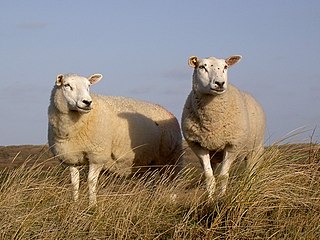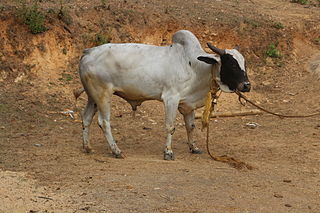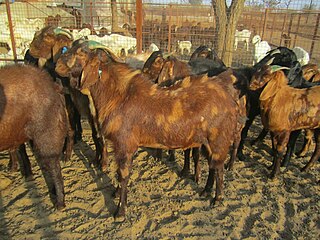Related Research Articles

The Blackface or Scottish Blackface is a British breed of sheep. It is the most common sheep breed of the United Kingdom. Despite the name, it did not originate in Scotland, but south of the border.

The Cotswold is a British breed of domestic sheep. It originates in, and is named for, the Cotswold hills of the southern midlands of England. It is a large long-woollen sheep, and is kept as a dual-purpose breed, providing both meat and wool.

The Jacob is a British breed of domestic sheep. It combines two characteristics unusual in sheep: it is piebald—dark-coloured with areas of white wool—and it is often polycerate or multi-horned. It most commonly has four horns. The origin of the breed is not known; broken-coloured polycerate sheep were present in England by the middle of the seventeenth century, and were widespread a century later. A breed society was formed in 1969, and a flock book was published from 1972.

The Lonk is a British breed of domestic sheep. It belongs to the group of black-faced hill breeds of northern England, and is found in the hills of the central and southern Pennines of Lancashire and Yorkshire. It is documented from the mid-eighteenth century; a flock book was started in 1905.

Bannur is a municipality in T.Narasipura Taluk, Mysore district in the state of Karnataka, India. It is located at 12.33°N 76.86°E. It has an average elevation of 654 metres (2,146 ft) T.Narasipura Taluk Near Somanathapur Temple. It is about 25 kilometers from the city of Mysuru and around 30 kilometres (19 mi)30 kilometers from Mandya

The Texel is a Dutch breed of domestic sheep originally from the island of Texel. It is a heavy and muscular sheep, and produces a lean meat carcass. It is polled, clean-faced and clean-legged, with white face and wool. The fibre diameter of the wool averages about 32 μ, with a staple length of 8–15 cm; it is used mainly for knitting and hosiery wools.

The Clun Forest is a breed of domestic sheep originating from the area surrounding the Clun Forest in Shropshire, England. Similar to many of the British breeds of upland sheep, Clun Forest are hardy, adaptable, good foragers, and are long–lived. With sleek heads and wide pelvic structures, Clun Forest ewes lamb easily. The breed has a short to medium–length wool and dark brown faces. They are a multi–purpose animal, kept for meat, wool, and milk. Like other dark faced sheep, Clun produce quality lamb and mutton. However, in contrast to more common meat breeds such as Suffolks, their wool is free of undesirable black fibres and kemp, and is suitable for handspinning. The breed's alert and stylish appearance, together with its reputation for hardiness and fecundity have made it popular with hobby farmers and large commercial flock owners alike. The Official Clun Sheep Breeders Society Show & Sale for males and females is held annually in early September at Ludlow livestock market by McCartneys.
The White Suffolk is a modern Australian breed of domestic sheep. It was bred from 1977 to have the meat-producing qualities of the Suffolk, but without the typical black markings.
The Devon Closewool is a British breed of domestic sheep. It is distributed almost exclusively on Exmoor in North Devon, in south-west England. It is raised primarily for meat.

The Deoni is an Indian breed of draught cattle. It is named after the taluk of Deoni in the Latur district of Maharashtra state, and is distributed mainly in the Latur, Nanded, Osmanabad and Parbhani districts of the Marathwada region of Maharashtra, as well as the Bidar district of Karnataka.

The Newfoundland, also called the Newfoundland Local, is a breed of sheep native to Newfoundland.
The Fabrianese is a modern Italian breed of domestic sheep from the Marche region of central Italy. It takes its name from the town and comune of Fabriano, in the province of Ancona. It was created as a dual-purpose breed in the 1960s by cross-breeding local breeds of the Apennines of the Marche with rams of the Bergamasca breed from the Alps of Lombardy. It is raised in the eastern foothills of the Apennines, in the provinces of Ancona, Ascoli Piceno and Macerata in the Marche, and in the province of Terni in Umbria.

The Kangayam or Kangeyam is an Indian breed of draught cattle from the state of Tamil Nadu, in South India. Its area of origin is Kongu Nadu, the region surrounding Coimbatore, close to the border between Tamil Nadu and Kerala, but it is distributed over a considerably wider area. The breed name derives from that of the town of Kangeyam. It may also be called Kanganad or Kongu.

The Sirohi is an Indian breed of domestic goat. It is named for its area of origin, the Sirohi District of Rajasthan, in north-western India. It may be described as a dual-purpose breed, reared for both meat and milk production, or as meat breed. It is well adapted to the dry tropical climate of Rajasthan.

The Marwari is an Indian breed of domestic sheep. It originates in, and is named for, the Marwar region of south-western Rajasthan, in the north-west of India. It is reared in the five principal districts of Marwar – Barmer, Jalore, Jodhpur, Nagaur and Pali – and also in some neighbouring districts of Rajasthan and Gujarat.
The Alpagota is a breed of sheep from the province of Belluno in the Veneto, in north-eastern Italy. It is particularly associated with the historic region of the Alpago, from which it takes its name, and is raised principally in that area.
The Brentegana is an Italian breed of sheep from the provinces of Trento and Verona in northern Italy. The name derives from that of the comune of Brentonico, the area where the breed is thought to have originated. Two distinct types are known: the Brentegana Scelta or Brentegana Trentina, a large heavy meat/wool type; and the Brentegana Comune, a medium-sized type more suitable for milk production. It is one of the forty-two autochthonous local sheep breeds of limited distribution for which a herdbook is kept by the Associazione Nazionale della Pastorizia, the Italian national association of sheep-breeders.

The Madras Red Sheep is an indigenous breed of sheep native to the northeastern parts of Tamil Nadu. The breed is characterized by medium size, reddish brown in colour with white markings on the leg and forehead. They are hardy and drought tolerant. Males are horned and ewes are polled. Wattles are found in about 73% females and 69% males. They feed on grass and a variety of tree leaves including those of Albizzia, Ficus, Leucaena, Gliricidia, Erythrina, Inga dulce and Thespesia. The breed is maintained mostly for meat and is one of five hairy breeds from Tamil Nadu. The breed has been traditionally developed and maintained in the Kancheepuram and Thiruvallur district by Naicker and Pillai communities. In an outbreak of sheep pox there was a mortality of up to 10% among adults, while the mortality was about 37% in adults of Mechery sheep. A virus similar to that causing Rift Valley Fever has also been noted to affect the sheep in an outbreak 1994. They breed during July to September.

The New Zealand Romney is a New Zealand breed of sheep. It derives from British Romney Marsh stock imported to New Zealand in the nineteenth century, and was established as a separate breed in 1904. It is the most numerous sheep breed in New Zealand.

The Cambridge is a modern British breed of domestic sheep. It was bred at the University of Cambridge by John Owen and Alun Davies between about 1964 and 1979, with the aim of increasing prolificacy. It is among the most prolific of all sheep breeds, but is critically endangered.
References
- ↑ "Sheep and Goat Breeds of India. R.M. Acharya. FAO Animal Health and Production Paper No. 30. Rome. 190 p. 1982". Animal Genetic Resources Information. 2: 45–46. April 1984. doi:10.1017/S1014233900003771. ISSN 1014-2339.
- ↑ "Livestock of the World" . Retrieved 15 August 2024.
- ↑ "Breed Profiles" . Retrieved 15 August 2024.
- ↑ Jain, A. Kulkarni, V.S., Govindaiah, M.G., Sadana, D.K., Aswathnarayan, T., Pandey, A.K., Kumar, D., Sharma, R. and Signh, G. 2005. Sheep Genetic Resources of India Bellary. ICAR Monograph, National Bureau of Animal Genetic Resources, Karnal, India. Pp24